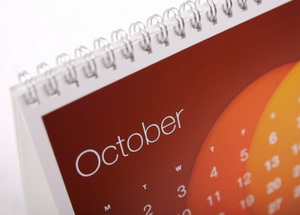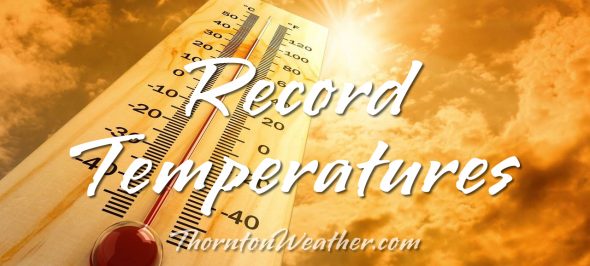
September is typically one of our quietest weather months and in fact it is our sunniest. That doesn’t however mean we can’t experience weather extremes. This week in Denver weather history we see everything from scorching heat and severe thunderstorms to snow and damaging wind. For more about September’s weather, check out our September weather preview.
1-5
In 1995…record breaking heat occurred on the first 5 days of the month when the temperature climbed into the 90’s on each day. Record high temperatures of 97 degrees on both the 1st and 4th equaled the all-time record maximum for the month. High temperature of 95 degrees on the 3rd was a record for the date. High temperatures of 94 degrees on both the 2nd and the 5th were not records. The low temperature of 64 degrees on the 4th equaled the record high minimum for the date.
1-7
In 1978…the temperature reached 90 degrees or more on seven consecutive days with the highest temperature…94 degrees… Recorded on both the 4th and 6th.
3-6
In 1909…rainfall for the 4 days accumulated to 3.97 inches in Boulder…while in Denver rainfall totaled 2.45 inches on the 4th…5th…and 6th.
5
In 1899…the highest recorded temperature in September…97 degrees…occurred. The same temperature was also reached on September 4…1960…and September 1 and 4…1995.
In 1940…a severe wind and hail storm confined mostly to the west and north parts of the city occurred shortly after 4:30 pm. Hail stones ranged in size from 1/4 to 1/2 inch in diameter. In north Denver…hail piled to a depth of 4 inches. Flooding occurred in one underpass…which stalled 2 cars. One girl was injured when the weight of the hail flattened a porch on which she stood. Northeast winds were sustained to 29 mph with gusts to 32 mph in downtown Denver.
In 1987…a thunderstorm complex produced hail as large as 1 3/8 inches in diameter…2 miles east of Buckley Field in Aurora. No damage was reported.
5-9
In 1988…layers of smoke aloft from large forest fires in Yellowstone National Park completely obliterated the sun at times. At Stapleton International Airport…surface visibility was reduced at times to 5 and 6 miles in smoke.
5-13
In 2010…the Fourmile Canyon Wildfire…northwest of Boulder… broke out on the morning of the 5th. It originated from an unattended fire pit at a local residence. The wildfire quickly consumed 5 1/2 square miles or 3500 acres the first day…and forced the evacuation of over three thousand residents. Erratic 45-mph gusts sent the fire in two directions at times. Very dry weather conditions preceded the fire. The combination of strong winds…low relative humidities and dry fuels allowed the wildfire spread rapidly through the steep…heavily forested terrain. The flames were reportedly 20 to 50 feet in length. Towns within the burn area included Salina…Wallstreet and Gold Hill. The dry conditions coupled with gusty winds ranging from 45 to 64 mph persisted for several more days. Fire managers used as many as 700 firefighters and support personnel from 35 agencies and seven air tankers to battle the wildfire. A total of 6181 square acres or approximately 10 square miles were burned. The Fourmile Canyon Wildfire was the most destructive fire in Colorado history in terms of the damage to personal property. It destroyed 171 homes with an estimated cost of 217 million dollars.
6
In 1940…a thunderstorm pelted the city with small hail. The storm produced some lightning damage. One woman was stunned by a bolt which struck near her. Heavy rain from the storm raised the level of Cherry Creek by more than 3 feet during the height of the storm. Rainfall downtown was only 0.26 inch.
In 1988…strong winds blew down two houses that were under construction in Castle Rock. Northwest winds gusted to 44 mph at Stapleton International Airport.
In 1993…a man was struck and killed by lightning while standing outside his home in unincorporated Arapahoe County 11 miles south of Denver. Lightning also struck a cabin in Marshdale…20 miles southwest of Denver…which started a fire and damaged one room and a portion of the roof.
In 1995…hail as large as 3/4 inch in diameter fell in Coal Creek Canyon in northern Jefferson County.
In 2001…a thunderstorm dropped 3/4 inch diameter hail in Aurora near Cherry Creek.
7
In 1875…the creeks were running dangerously high during the night from heavy rains in the mountains.
In 1885…a thunderstorm produced very white hail of irregular shape and about the size of beans. Precipitation was only 0.10 inch.
In 1971…a vigorous cold front accompanied by a thunderstorm produced wind gusts to 48 mph at Stapleton International Airport and much upslope cloudiness and light rain across metro Denver.
In 1989…widespread thunderstorms produced lightning strikes that knocked out power to about 13 thousand homes in Boulder County. In a rugged area stripped of vegetation by a forest fire earlier in July…heavy rain triggered mud slides that destroyed one home and severely damaged another in Boulder canyon 10 miles west of Boulder. In one home…the mud caved in an exterior wall and poured into the residence only seconds after 2 people had evacuated the premises. Rainfall totaled 1 to 3 inches. Hail 1 3/4 inches in diameter fell in Nederland…Idaho Springs…and Golden Gate Canyon. Hail 1 inch in diameter was measured 10 miles north of Golden.
In 1993…thunderstorm winds toppled an overhead sign onto the intersection of I-70 and I-25 in Denver…causing considerable damage to 4 vehicles. The winds also caused a police car to be blown off the road northeast of Denver. Thunderstorm winds gusting to 66 mph damaged the siding of a residence southeast of Brighton. A thunderstorm wind gust to 53 mph was recorded at Stapleton International Airport. Hail to 7/8 inch in diameter fell at Kittredge in the foothills of Jefferson County.
In 1994…lightning severely damaged a public television transmitter atop Squaw Mountain west of Denver.
7-8
In 1884…a windstorm from mid-afternoon until the early morning hours of the 8th produced south winds sustained to 48 mph. The strong winds toppled several trees in the city.
In 1892…there was a trace of rainfall each day. This together with a trace of rain on both the 2nd and 3rd was the only rainfall of the month…making the month the driest on record. The record was equaled in 1944.
Continue reading September 5 to September 11: This week in Denver weather history →
 With the first full month of fall here, October usually brings one of the quietest weather months in the Denver area with plenty of mild, sunny days and clear, cool nights.
With the first full month of fall here, October usually brings one of the quietest weather months in the Denver area with plenty of mild, sunny days and clear, cool nights.



 Following an August that was unseasonably warm and dry, we find ourselves heading into September hoping for relief. The month can bring plenty of rain and even our first snow of the season but more often than not, it is one of the most pleasant along the Colorado Front Range.
Following an August that was unseasonably warm and dry, we find ourselves heading into September hoping for relief. The month can bring plenty of rain and even our first snow of the season but more often than not, it is one of the most pleasant along the Colorado Front Range.